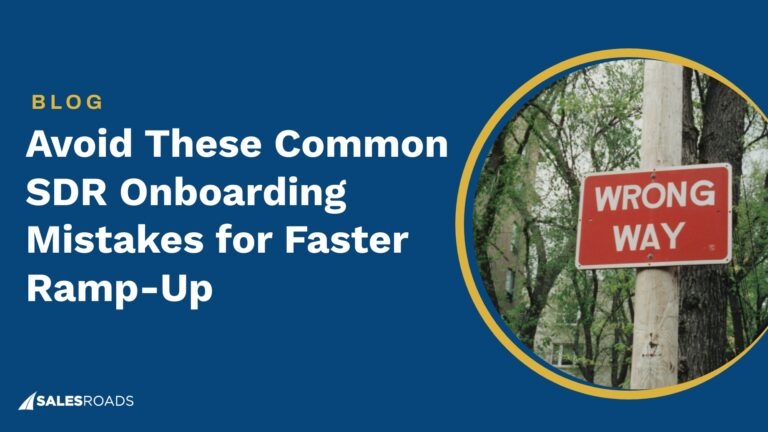There’s nothing worse for an SDR than getting an immediate rejection for feeling nervous or unprepared while calling a lead. Appointment setting conversations are cold calls and an effective script helps SDRs overcome challenges by providing a guide with the best strategies to use on the phone.
Effective templates are built on possible scenarios between the caller and the prospect to prevent salespeople from being caught off guard. Top professionals tailor each script to their particular industry, client, and offerings for the best results.
Why do You Need an Appointment Setting Script?
SDRs are more likely to misqualify leads or fail to capture important information without a solid appointment setting script. Scripts function as a guide for the sales call, but getting too dependent on them can also impair the process.
You need an appointment setting script because it:
- Helps SDRs appear confident – Appointment setting scripts detail responses to possible objections, allowing SDRs to take charge of the conversation and guide it towards the appointment.
- Minimizes chances of call termination – Most SDRs reach out to prospects that still don’t know much about the brands the SDRs represent. A high-quality script can help make a good first impression so the conversation flows naturally.
- Showcases brand identity – An appointment setting script gives you the opportunity to showcase your brand’s unique tone and message, resonating with your company and core audience.
Templated appointment setting scripts equip Sales Development Representatives (SDRs) for effective calls by providing a structure for conversation, enabling persuasive discussions, and maintaining a consistent brand message. However, they may not always suit the dynamic flow of a conversation and can create over-dependence, resulting in complacency among SDRs.
While scripts offer value in preparing SDRs and ensuring consistency, they should be used flexibly and in conjunction with adequate research to avoid creating poor first impressions.
Anatomy of a High-Quality Appointment Setting Script
A high-quality appointment setting script must be tailored to your company. There’s no one-size-fits-all approach when creating a script, but it should contain the following components:
Opening statement
The opening statement of an appointment setting script should be the SDRs introducing themself and the company they represent.
“Hi [lead’s name], I’m [SDR’s name] from [company]”
The tone should be upbeat and enthusiastic to set a positive tone for the conversation. It should also reflect the brand’s image and resonate with the core audience. To achieve this, SDRs must practice the delivery tone for their opening statement.
A strong opening statement makes the lead comfortable continuing the conversation. This can be done by addressing the lead by their name to create a familiar atmosphere, which also shows that the SDR has done research beforehand.
In some cases, the person who answers the call is a gatekeeper like a secretary or personal assistant. The script should also contain effective strategies for dealing with gatekeepers.
Qualification statement
After making a positive impression with the call opener, the next step is qualifying the lead. This enables SDRs to determine whether the lead is the right fit, especially when they have a diverse list.
Qualification statements mostly contain questions that:
- Probe for pain points
- Determine who is the decision maker
- Ascertain if the prospect is planning to make a purchase
- Confirm how the prospect feels about their current solution
Before asking questions, confirm the lead has time to spare. If they don’t, ask for a good time to continue the conversation. SDRs must always be courteous and respectful during phone calls, even when the lead answers negatively.
David Kreiger highlights five questions that SDRs should never ask on appointment setting calls:
Appointment statement
Once SDRs determine the lead is qualified, the next step should be scheduling an appointment. This is the easiest part of the script, as SDRs simply have to ask the lead for a convenient time to talk with the account executives.
When setting an appointment, provide a few options but stay objective. Instead of asking “When should we schedule your appointment?”, you can say “We have an available schedule on Tuesday and Wednesday, when would you prefer?”
After the lead chooses a schedule, confirm the date to prevent any misunderstanding.
Should a lead fail to meet the qualifying criteria, SDRs should graciously thank them for their time and say goodbye. Maintaining professionalism regardless of the lead’s status, bolsters the brand’s reputation and visibility.
Closing statement
The closing statement allows SDRs to wrap up the conversation and confirm the appointment by reiterating the schedule. This is also a great avenue to answer any lingering questions the prospect may have.
If the lead has no more questions, end the call with a simple but upbeat goodbye, expressing a clear anticipation of the future conversation. On the importance of closing statements, Matthew Ramirez says “It is an opportunity to remind the lead that you’re worth talking to again. You can show your human side and be relatable.”
Tips for Creating an Effective Appointment Setting Script
Creating an effective appointment setting script often requires trial and error. You can minimize mistakes by:
- Understanding your target audience: The key to creating an effective appointment setting script is to write it for your company’s buyer persona.
- Leaving room for personalization: The appointment setting script must work for leads of backgrounds and positions. Personalization can give leads a more tailored experience and increase engagement.
- Making it a two-way conversation: Avoid making discovery calls sound like interviews. They should be conversations where the leads have room to talk and express their ideas and opinions. Making a short pause after every question can help achieve this.
Appointment Setting Script Samples
SDRs can use any of these scripts to guide their appointment setting conversations. Each sample contains an opening statement (O), a qualification question(Q), an appointment setting question (A), and a closing statement(C).
Opening statements across these scripts are similar and focus on introducing yourself to the prospect. The rest of the script varies depending on the specific context and call intent.
When you notice a vacancy or new hire
This template is great for SDRs who have discovered through social media or other sources that a prospect company is hiring or has recently filled a position.
[Opening]
[pause]
Q: “I am reaching out because I noticed that you just got hired as [role] at [company]. Congratulations, how’s it going?”
or
Q: “I noticed your company has an opening for [role]. Is there an issue with that [department], or is [company] expanding business?”
[pause]
You can continue the conversation by introducing your products and services in response to their answers.
A: “I’d like to know the possibility of [prospect company] and [your company] working together. Can we set up a meeting to discuss [your product]? When is a good time for you?”
This script is effective for appointment setting because it provides a legitimate reason for the outreach and portrays you as a valuable entity to the prospect.
When you’re unsure of the contact
This script is ideal for SDRs who want to ensure they’re contacting the correct person at the prospect company and not gatekeepers. It is useful for B2B salespeople in enterprise, SaaS, and tech deals.
[opening]
[pause]
Q: “I’m onto [prospect’s company], right?”
[pause]
Q: “Great. I’m trying to reach the [role] for [prospect company]. I’ve checked your website and social media, but I’d like to make sure I have the right number.”
[pause]
You can then schedule an appointment if you’ve successfully reached the decision-maker.
Q: “Nice to meet you. I wanted to speak about setting up a quick appointment to discuss [your product].”
This template holds a positive approach that benefits you: even if you don’t reach the right person, the rapport can help you get to the decision-maker.
When your product deals with a common pain point
This is an excellent template for B2B appointment setters and SaaS salespeople offering products or services that address major industry pain points.
[opening]
[pause]
Q: “I saw you work at [prospect company] and decided to contact you.
We help startups and established businesses in [industry] to deal with [pain point]. Our expertise has allowed us to [save/prevent/reduce] our client’s [pain point] by [percentage/data point/amount] in [period].”
[pause]
“How do you currently deal with [pain point]?”
Or
“If you don’t mind me asking, are you using any other solutions for [pain point]?”
Or
“Could you tell me about [prospect company] strategies for [pain point]?”
[pause]
A: “[Your company] has just what you need. Let’s set an appointment to talk about how [your product] deals with [pain point]. I’m looking at my calendar…”
Offering to assist your prospects to save money or reduce problems presents you as a helper instead of a pushy salesperson. It is easier to build trust on the foundation of the former.
When you’ve been referred
Appointment setters can use this template to leverage relationships and fix quick meetings. This script is useful when the mutual party has not made introductions, as it provides ice-breakers for potentially awkward situations.
[opening]
[pause]
Q: “I’m reaching out because [referrer] suggested that we should get in touch. Did [referrer] talk to you about [your company] or the possibility of working together?”
[pause]
Q: “Can you please tell me how you know [referrer]?”
If you both share a close relationship with the referrer, you can move the conversation in a light-hearted, informal direction. Otherwise, you can concentrate on fixing an appointment using facts from the dialogue.
When you need to be direct
This template is short and straightforward for booking appointments. It is a perfect script for salespeople who are limited by time or lack accurate information about their prospects.
[opening]
[pause]
Q: “I understand that [prospect company] might be looking for new solutions for [pain point], and I think [your company] and [prospect company] will make great partners.
I suggest we set up a time to discuss [mutual objectives] and understand how we can help each other. How about [time and date]?”
Many prospects appreciate direct SDRs and see it as respect for their time.
Best Practices for Using Appointment Setting Scripts
Focus on setting the appointment
Prospects may persuade SDRs to sell the product or send pricing details during an appointment setting call. Giving into these may derail the conversation and make scheduling a meeting difficult. Salespeople can use templates to focus on setting the appointment, warding off these distractions.
Ask discovery questions
SDRs who ask the right probing questions learn new things about their prospects and qualify them better for the sale/purchase. The script can help to drive the appointment but their responses give more context to their painpoints and can improve appointment setting success.
Do quality research
Researching your prospects before arranging a meeting is vital for your value proposition. What you know about each prospect helps position your product in the best possible way.
Combining your pre-call research with the script provides opportunities to personalize your outreach which allows you to set more appointments.
Always confirm appointment details
At the end of the call, you must have the following information:
- Date and time of the appointment
- Meeting participants
- Meeting agenda
- Meeting medium (virtual or physical)
These details should be accurate, as they are the essence of a successful appointment setting call. SDRs can forward them to AEs along with meeting notes in preparation for future conversations.
Practice your script
Regularly practice your script to ensure smooth and confident delivery on the appointment setting call. The more familiar you are with the script, the less likely you are to stumble or sound unnatural.
Test and review
Periodically review and update your script based on results from your appointment setting campaigns. Managers can hold meetings with their SDRs at intervals to get frontline feedback and identify areas for improvement.
Bottom Line
An effective appointment setting script must have a clear opening line followed by qualification, appointment, and closing statements. You’ll also need to understand your target audience to ensure that the script resonates with them.
Appointment setting is critical for lead generation, and managers who maximize it can significantly improve their sales processes. Team leaders can encourage SDRs to use the templates and recommendations above to attract more prospects and increase revenue.
FAQS
Why are appointment setting scripts important?
Scripts maintain consistency and professionalism across your appointment setting calls. They help SDRs cover keypoints, overcome objections, and guide the conversation towards setting an appointment.
Should I read the script word-for-word?
No, scripts serve as a guide rather than a verbatim script. It’s important to sound natural and adapt to the flow of each conversation.
How do I personalize appointment setting scripts?
SDRs can personalize scripts by mentioning the prospect’s first name, referencing their business or industry, and tailoring the value proposition to their specific pain points.
How can I make my script sound more natural?
Practice is key. The more familiar you are with the script, the more naturally you can deliver it. Also, use conversational language and avoid industry jargon.











